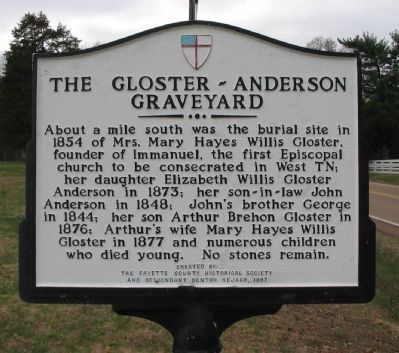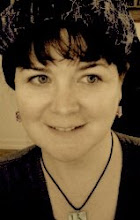There were two local students named Gloster at the Mordecai school in its early years; Arthur Gloster was there in 1809 and 1810, and Elizabeth Gloster was there from 1809 through 1811. Both were the children of Thomas Gloster, an Irish-born local physician in Warrenton, and his wife, Mary Hayes Willis Gloster. These siblings both had paragraphs in my dissertation appendix, so much of the following is taken from there.
In 1996 I knew that Elizabeth Willis Gloster was born in 1796, married Jack Anderson in 1814, had about ten children, was widowed in 1848, and died in 1873. (I encountered her more during my post-doctoral work in the Cameron Family Papers, because Jack Anderson was a Cameron cousin.) Elizabeth Gloster Anderson attended the last "reading of the cards" at the Mordecai school in 1818, saying that she had also been there for the first such event. She was also at the school's last examination. Elizabeth Gloster Anderson raised the daughter of her classmate Eliza Adam Cameron, and was close to Caroline Mordecai Plunkett into the 1820s.
Elizabeth (also known as Betsy) moved to western Tennessee in 1827, with her husband and children, and her mother and brother too. She had asthma, and found Tennessee's climate more healthful, and reported in her letters that she was walking seven or eight miles without being fatigued. Her husband started an Episcopal church there. Caroline Mordecai Plunkett also moved to western Tennessee, in 1833, and Betsy taught drawing at Caroline's school there. So she's one of the Mordecais' first students, and one that continued her connection to the family well into adulthood, and across many miles. She moved to Texas in 1859. Her papers are in the Southern Historical Collection at UNC.
Elizabeth's younger brother Arthur Brehon Gloster, born 1799, went to West Point Military Academy in 1819, but he did poorly on exams and was back in Warrenton by 1821. He moved to Tennessee when the Andersons did, and married a cousin, Mary, in 1829. Arthur and Mary ran a tavern in La Grange, Tennessee, and had at least eleven children, all born and baptized in Tennessee, according to the family Bible I looked at in Warren County. Most of them died young; the only living son at the time of the Civil War died as a soldier for the Confederacy.
(Although the Mordecai school was considered a girls' school, there were
some male students, usually young boys from Warrenton who had a sister
or other female relative also attending.)
The family's Tennessee graveyard has a historic marker, though the stones do not survive.
Want to see a quilt that Elizabeth Gloster Anderson made in 1844? Sure you do! The Henry Clay Estate at Ashland has this one, a political quilt supporting Henry Clay:



No comments:
Post a Comment